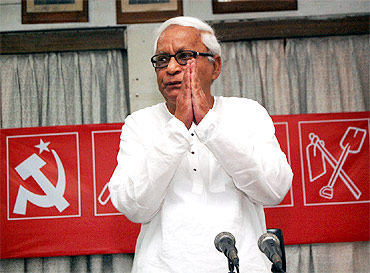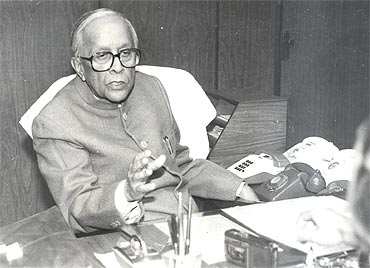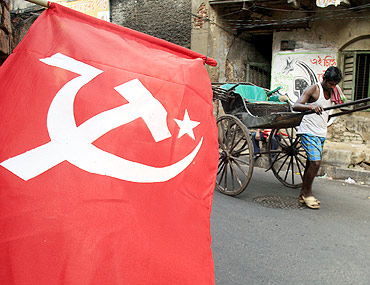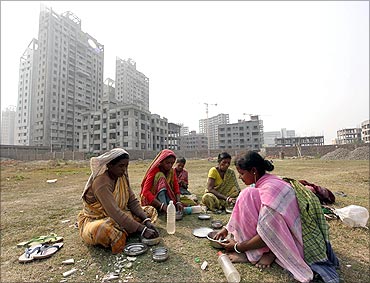Ishita Ayan Dutt in Kolkata
In July 1998, Bata managing director Keith Weston was hospitalised with a deep gash following an assault from a trade union leader.
For anti-capitalist trade unions, it was a pyrrhic victory that set the stage for the company's exit in 2003.
For Bengal, the company's flight was another is a long list of lost businesses that began the mid-1980s.
"Gherao is our contribution to the dictionary," former chief minister Buddhadeb Bhattacharjee was often heard saying.
. . .
Why business houses left Bengal
Image: Buddhadev Bhattacharjee.Photographs: Reuters
He had realised the damage done by his predecessor Jyoti Basu, albeit a little too late.
If Basu is credited for his agricultural policies, his flawed industrial policy draws twice the flak.
Putting it simply, his was a regime marked by bandhs, gheraos and militant trade unionism and could easily be called the worst of the times for industry in the state.
Retired professor of economics at the Indian Statistical Institute, Dipankar Dasgupta, analyses those times:
"When they came to power, they were insecure and needed to ensure that the vote bank was with them.
. . .
Why business houses left Bengal
Image: Jyoti Basu in his office in Writers' Building, Kolkata.Photographs: Apurba Ash.
"At that time, 75 per cent or more of the state's population was in the rural side, but that did not mean that industry had to be neglected.
"Left Front had a strong ideology, a typical Marxian one, unlike today, where the capitalist was the exploiter and workers were the exploited.
It gave the workers a false sense of power, leading to demands that couldn't be fulfilled. As demands intensified over time, entrepreneurs started feeling nervous.
"Striking became a culture and industrialists could not tolerate such an environment for long."
And they didn't.
M L Mittal, the founder chairman of the Ispat group, began his journey with the takeover of an ailing rolling mill in Kolkata. Kolkata could well have been home to Ispat Industries, until recently controlled by Mittal's sons -- Pramod and Vinod -- with net sales of around Rs 9,000 crore (Rs 90 billion), but they chose to seek refuge in Maharashtra.
. . .
Why business houses left Bengal
Image: A street in Kolkata.In 1994-95, the company's corporate headquarters was moved to Mumbai.
The loss pinches more today, as the company is now part of the JSW Steel Group and the combined entity is set to be India's largest private sector steel maker, evena as JSW Steel is setting up a plant at Salboni in West Medinipur.
"The state was not going anywhere, its growth was being hampered. So all major plants were set up in Maharashtra, because it provided the critical growth factors like a growing market and economy," says Anil Sureka, executive director, Ispat Industries.
The Mittals homed in on Maharashtra to set up a one-million-tonne sponge iron plant at a cost of Rs 800 crore (Rs 8 billion).
. . .
Why business houses left Bengal
That the economy would be in a slow gear was more of a foregone conclusion, especially since striking work had become a way of life. And it wasn't for Basu to change the culture.
In May 1985, when Basu's government signed an agreement to set up Haldia Petrochemicals, he was chastised by his party colleagues.
Later, the line had to be endorsed by the party (Communist Party of India - Marxist) congress. Such was communists' fear of the capitalist.
In Kolkata, and Bengal, the story being played at all industrial works was pretty much the same, as was the consequence.
From the mid-1980s one company after another moved its headquarters away from the epicentre of labour problems -- from tea major Brooke Bond India to ICI India, Shaw Wallace, Singhanias of JK Tyre and electronics giant Philips India, which incidentally was born in Kolkata.
. . .
Why business houses left Bengal
Image: Kolkata.Photographs: Courtesy, West Bengal Tourism.
Though Bengal's growth wasn't far behind the national average during Basu's regime, when the other states started growing at a scorching pace after liberalisation, Bengal was still growing at a snail's pace.
An Indicus Analytics report pointed out: West Bengal's net state domestic product, a measure of how much a state's citizens are producing, at 1999-2000 constant prices, was Rs 27,000 crore (Rs 270 billion) in 1960-61, while Maharashtra's was at comparable levels of Rs 33,200 crore (Rs 332 billion).
In 2005-06, Bengal's NSDP stood at Rs 173,800 crore (Rs 1,738 billion), while Maharashtra's zoomed to Rs 302,900 crore (Rs 3,029 billion).
. . .
Why business houses left Bengal
Image: Labourers eat food at the site of a residential estate under construction in Kolkata.Photographs: Rupak De Chowdhuri/Reuters.
The gap had widened significantly.
There is no dearth of counts in which Bengal lost out to others. Hindustan Motors, once India's and Bengal's pride, faced labour problems at its Uttarpara plant intermittently.
In the mid-1990s, when competition pulled down the company from its heyday glory, wages at the Uttarpara plant accounted for 22 per cent of the plant expenditure.
When the company decided to shed workforce, trade unions, with a complete backing of the Left Front-led West Bengal government, resisted.
Cumulative investments till 2000, when Basu gave up office, stood at just about Rs 17,000 crore (Rs 170 billion).
. . .
Why business houses left Bengal
Image: Eight-year-old Rupa performs on a tightrope at a roadside in Kolkata.Photographs: Rupak De Chowdhuri/Reuters.
Even when Basu had tried to mend his ways and come up with an industrial policy in 1994, his colleagues were not ready to change.
Industry was the most obvious casualty of the Left's excesses.
The impact: West Bengal today has one of the highest unemployment levels, of 64 million.
In 1985, Rajiv Gandhi had said: "Calcutta is a dying city."
The comment rankled Calcuttans (as opposed to Kolkatans now) and they protested rather raucously.
But protest is probably the commonest form of expression in Bengal.
With the Left gone, is there going to be any qualitative paribartan (change) in Bengal's protest culture that may work in favour of industry?
There is no clear answer to this right now, but packing off of a project like the Nano by the present government, may not be a record to go by.










article